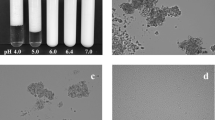Abstract
An ethanol extraction method was studied for the production of dairy lecithin from cheese whey-derived milk fat globule membrane (MFGM). A two-step ethanol extraction of MFGM involving first extraction at pH 6.5, followed by second extraction at pH 4.5 yielded 17.2 % lipids. The extracted material contained about 90 % lipids, 4.5 % ash, and 1.2 % moisture. The phospholipid content of the ethanol extract was 31 % and the remainder was mostly neutral lipids. The phospholipid fraction contained 34 % sphingomyelin, 31 % phosphatidylcholine, 27 % phosphatidylethanolamine, 4.6 % phosphatidylserine, and 3.1 % phosphatidylinositol. Since the ethanol extract contained 31 % phospholipids, it can be technically termed as dairy lecithin. The major fatty acid components were linoleic acid (5.1 %), myristic acid (8.3 %), palmitic acid (29 %), stearic acid (14 %), oleic acid (25 %), and the remainder was minor fatty acids with chain length ranging from C4:0 to C22:5. The dairy lecithin was semi-solid at room temperature and exhibited a major phase transition at about 35 °C. Owing to its low polyunsaturated fatty acid content, the dairy lecithin was reasonably stable to oxidation as measured by the rate and extent of hexanal production during 35 days of storage at 45 °C. Oil-in-water emulsions made with less than 2 % dairy lecithin (relative to the total emulsion weight) were unstable; however, emulsions made with greater than 4 % dairy lecithin were very stable for more than 60 days at room temperature. The results of this study indicated that a highly functional dairy lecithin can be commercially produced using cheese whey-derived MFGM as the starting material.







Similar content being viewed by others
References
Van Nieuwenhuyzen W (1981) The industrial uses of special lecithins. J Amer Oil Chem Soc. 58:886–888
Krawczyk T (1996) Lecithin: consider the possibilities. Inform 7:1178–1187
Spitsberg VL (2005) Invited review: bovine milk fat globule membrane as a potential nutraceutical. J Dairy Sci 88:2289–2294
Vesper H, Schmelz EM, Nikolova-Karakashian MN, Dillehay DL, Lynch DV, Merrill AH Jr (1999) Sphingolipids in food and the emerging importance of sphingolipids to nutrition. J Nutrition 129:1239–1250
McDaniel MA, Maier SF, Einstein GO (2003) “Brain-specific” nutrients: a memory cure? Nutrition 19:955–956
Oshida K, Shimizy T, Takase M, Tamura Y, Shimizu T, Yamashiro Y (2003) Effect of dietary sphingomyelin on central nervous system myelination in developing rats. Pediatric Res 53:580–592
Kanno C, Kim DH (1990) A simple procedure for the preparation of bovine milk fat globule membrane and a comparison of it composition, enzymatic activities, and electrophoretic properties with those prepared by other methods. Agric Biol Chem 54:2845–2854
Morin P, Jimenez-Flores R, Pouliot Y (2007) Effect of processing on the composition and microstructure of buttermilk and its milk fat globule membranes. Int Dairy J 17:1179–1187
Damodaran S (2010) Zinc-induced precipitation of milk fat globule membranes: a simple method for the preparation of fat-free whey protein isolate. J Agric Food Chem 5:11025–11057
Damodaran S (2011) A straightforward process for removal of milk fat globule membranes and production of fat-free whey protein concentrate from cheese whey. J Agric Food Chem 59:10271–10276
Zhu D, Damodaran S (2011) Composition, thermotropic properties, and oxidative stability of freeze-dried and spray-dried milk fat globule membrane isolated from cheese whey. J Agric Food Chem 59:8931–8938
Catchpole OJ, Tallon SJ, Grey JB, Fletcher K, Fletcher AJ (2008) Extraction of lipids from a specialist dairy stream. J Supercritical Fluids 45:314–321
Palacios LE, Wang T (2005) Extraction of egg-yolk lecithin. J Amer Oil Chem Soc 82:565–569
Astaire JC, Ward R, German JB, Jimenez-Flores R (2003) Concentration of polar MFGM lipids from buttermilk by microfiltration and supercritical fluid extraction. J Dairy Sci 86:2297–2307
Cabezas DM, Diehl BWK, Tomas MC (2009) Sunflower lecithin: application of a fractionation process with absolute ethanol. J Amer Oil Chem Soc 86:189–196
Hollo J, Peredi J, Ruzics A, Jeranek M, Erdelyi A (1993) Sunflower lecithin and possibilities for utilization. J Amer Oil Chem Soc 70:997–1001
Folch J, Lees M, Sloane Stanley GH (1957) A simple method for the isolation and purification of total lipids from animal tissues. J Biol Chem 226:497–509
Wehr HM, Frank JF (2004) Standard methods for the examination of dairy products, 17th edn. The American Public Health Association, Washington, DC
AOCS (1996) Official methods of analysis. Association of Official Analytical Chemists, Washington, DC
Wu Y, Wang T (2003) Soybean lecithin fractionation and functionality. J Amer Oil Chem Soc 80:319–326
GiuffridaF Golay P-A, Destailiats F, Hug B, Dionisi F (2011) Accurate determination of hexanal in beef bouillons by headspace solid-phase microextraction gas-chromatography mass-spectrometry. Eur J Lipid Sci Technol 107:792–798
Boyd LC, Dyre NC, Hansen AP (1999) Isolation and characterization of whey phospholipids. J Dairy Sci 82:2550–2557
Acknowledgments
This research was funded by a grant from the Graduate School at the University of Wisconsin-Madison under the Innovation and Economic Development Research program.
Author information
Authors and Affiliations
Corresponding author
About this article
Cite this article
Zhu, D., Damodaran, S. Dairy Lecithin from Cheese Whey Fat Globule Membrane: Its Extraction, Composition, Oxidative Stability, and Emulsifying Properties. J Am Oil Chem Soc 90, 217–224 (2013). https://doi.org/10.1007/s11746-012-2152-5
Received:
Revised:
Accepted:
Published:
Issue Date:
DOI: https://doi.org/10.1007/s11746-012-2152-5




